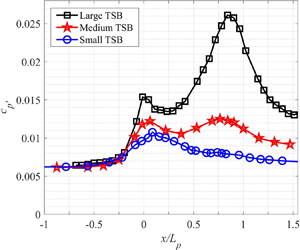Article contents
Measurements of pressure and velocity fluctuations in a family of turbulent separation bubbles
Published online by Cambridge University Press: 07 September 2020
Abstract

Measurements of wall-pressure and velocity fluctuations are performed in a family of three incompressible, pressure-induced, turbulent separation bubbles (TSBs) of varying sizes, with an emphasis on the energetic low and medium frequencies. In all three cases the streamwise distribution of wall-pressure fluctuations shows a bi-modal character, with a first local maximum close to the position of maximum adverse pressure gradient and a second local maximum at the very end of the region of intermittent back flow. The first maximum is shown to be caused by the superposition of two separate phenomena occurring at approximately the same streamwise position: first, the pressure signature of a low-frequency contraction and expansion (breathing) of the TSBs, whose amplitude is shown to increase with the size of the separation bubble, and second, the effect of the adverse pressure gradient on the turbulent structures responsible for the pressure fluctuations in the attached boundary layer. The second maximum of the wall-pressure fluctuation coefficient also increases with the size of the TSB and is associated with the convection of large structures within the shear layer. Possible scaling laws are examined to show that both the local maximum Reynolds shear stress  ${-\rho \overline {u'v'}_{max}}$ and the local maximum wall-normal stress
${-\rho \overline {u'v'}_{max}}$ and the local maximum wall-normal stress  ${\rho \overline {v'v'}_{max}}$ are adequate to scale the pressure fluctuations along the TSBs, with a better match when low frequencies are removed. Furthermore, a comparison with existing data from the literature illustrates the effects of Reynolds number and TSB size on the wall-pressure and velocity fluctuations. Finally, measurements in the spanwise direction demonstrate that, although corner effects strongly distort the average flow, the scaling of wall-pressure fluctuations with the turbulent stresses remains relatively unaffected. The present results provide new insights into the unsteady character of pressure-induced turbulent separation bubbles and their associated wall-pressure fluctuations.
${\rho \overline {v'v'}_{max}}$ are adequate to scale the pressure fluctuations along the TSBs, with a better match when low frequencies are removed. Furthermore, a comparison with existing data from the literature illustrates the effects of Reynolds number and TSB size on the wall-pressure and velocity fluctuations. Finally, measurements in the spanwise direction demonstrate that, although corner effects strongly distort the average flow, the scaling of wall-pressure fluctuations with the turbulent stresses remains relatively unaffected. The present results provide new insights into the unsteady character of pressure-induced turbulent separation bubbles and their associated wall-pressure fluctuations.
- Type
- JFM Papers
- Information
- Copyright
- © The Author(s), 2020. Published by Cambridge University Press
References
REFERENCES
- 12
- Cited by



